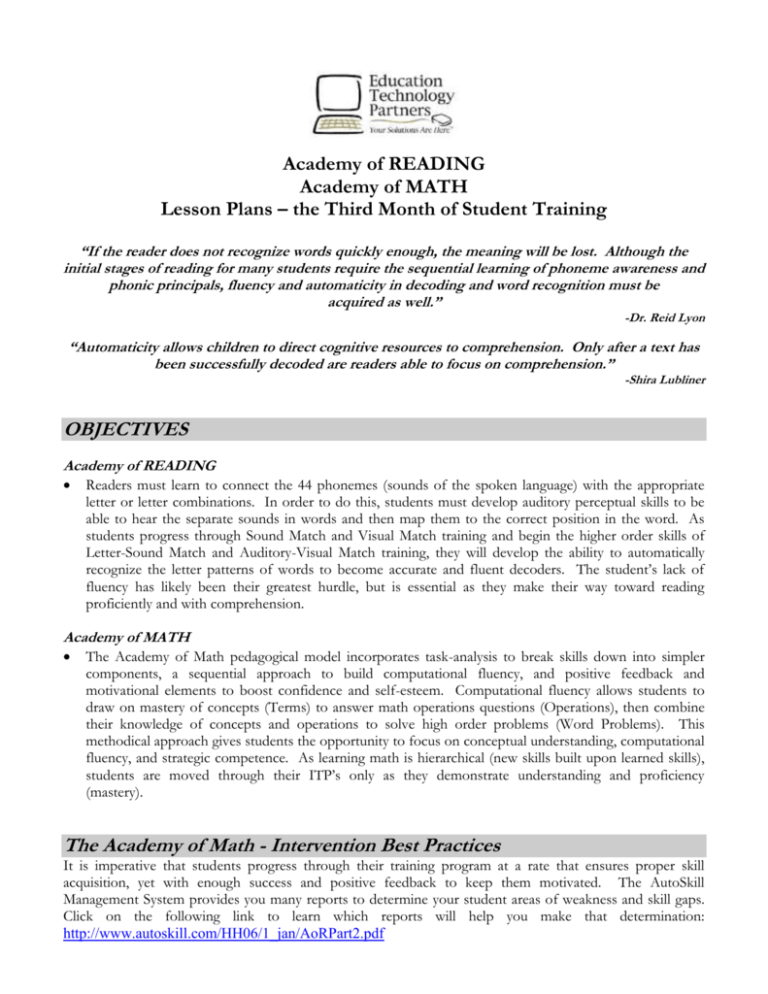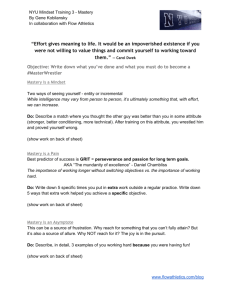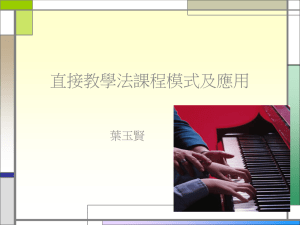Academy Lesson Plans & Activities – 3rd Month
advertisement

Academy of READING Academy of MATH Lesson Plans – the Third Month of Student Training “If the reader does not recognize words quickly enough, the meaning will be lost. Although the initial stages of reading for many students require the sequential learning of phoneme awareness and phonic principals, fluency and automaticity in decoding and word recognition must be acquired as well.” -Dr. Reid Lyon “Automaticity allows children to direct cognitive resources to comprehension. Only after a text has been successfully decoded are readers able to focus on comprehension.” -Shira Lubliner OBJECTIVES Academy of READING Readers must learn to connect the 44 phonemes (sounds of the spoken language) with the appropriate letter or letter combinations. In order to do this, students must develop auditory perceptual skills to be able to hear the separate sounds in words and then map them to the correct position in the word. As students progress through Sound Match and Visual Match training and begin the higher order skills of Letter-Sound Match and Auditory-Visual Match training, they will develop the ability to automatically recognize the letter patterns of words to become accurate and fluent decoders. The student’s lack of fluency has likely been their greatest hurdle, but is essential as they make their way toward reading proficiently and with comprehension. Academy of MATH The Academy of Math pedagogical model incorporates task-analysis to break skills down into simpler components, a sequential approach to build computational fluency, and positive feedback and motivational elements to boost confidence and self-esteem. Computational fluency allows students to draw on mastery of concepts (Terms) to answer math operations questions (Operations), then combine their knowledge of concepts and operations to solve high order problems (Word Problems). This methodical approach gives students the opportunity to focus on conceptual understanding, computational fluency, and strategic competence. As learning math is hierarchical (new skills built upon learned skills), students are moved through their ITP’s only as they demonstrate understanding and proficiency (mastery). The Academy of Math - Intervention Best Practices It is imperative that students progress through their training program at a rate that ensures proper skill acquisition, yet with enough success and positive feedback to keep them motivated. The AutoSkill Management System provides you many reports to determine your student areas of weakness and skill gaps. Click on the following link to learn which reports will help you make that determination: http://www.autoskill.com/HH06/1_jan/AoRPart2.pdf The Academy of READING – Auditory-Visual Match Classroom Activity Auditory-Visual Match; CVVC Letter Patterns using Vowel Diphthongs & Diagraphs OBJECTIVE: To review the sound of diagraphs and diphthongs. This skill emphasizes the use of diphthongs. A diphthong is a combination of one or more vowels making one sound- ow, ou, aw, ie, ei PROCEDURE: On the chalkboard, print the word family you wish to emphasize. Begin by writing the first line to a poem, with the final word a member of your chosen word family. Proceed by letting volunteers give additional lines, all ending with a word of that family. Example: Ow (Diphthong) I saw a purple cow He left my house just now His garden he must plow To plant his lovely flowers Around a giant tower Some diphthongs you may wish to utilize in this activity are: ee :weep ie: tied oa: coat ea: mean heel lies coal beam feel dies goat heat ai: wait pail bail Academy of READING – Letter-Sound Match Classroom Activity Letter-Sound Match: Blending Words with 3 or 4 Phonemes OBJECTIVE- To introduce the concept of blending and segmentation. The ability to blend individual sounds indicates the students are aware of, and can direct their attention to, the component sounds in words and reflects their understanding of the nature of the sound system. Phonemic Segmentation involves the ability to direct and focus attention on the separate sounds in a word. The objective is to build relationships between sounds and what word these sounds stand for or represent when put together. Activity 1: Rubber Band Stretch Teacher models with a large rubber band how to stretch out a word (like man) as the word is said, i.e. “man”- mmmmmm/aaaaaaaa/nnnnnnnn/ When bringing the rubber band back to its original length, say the word “man”. Students will then be asked to pretend to stretch rubber bands as they say the sounds in different words. Students will try to guess the word that is being “stretched” or blended. Activity 2: Word Segmentation This activity can use: (a) 4 by 4 inch square pieces of cardboard with letters on them; (b) a chalk or white board; or (c) a magnetic board and letters. The teacher pronounces a 3 or 4 phoneme word. The objective is for the student to place or write the letter for each sound as you pronounce the word. This lesson can be enhanced by asking the students, “What sound do you hear in the beginning? In the middle? At the end?” Students are building these words through segmentation. 2 Academy of READING – Making Modifications If a student is having difficulty mastering a single skill and is getting frustrated, you may consider making modifications to the students’ training assignment. If the automatic interventions combined with your efforts to work individually with the student have not succeeded in helping the student understand how to master the skill, the teacher can alter the mastery criteria for that single skill to allow the student to move on. This would be done to prevent frustration reaching unacceptable levels resulting in an unmotivated student. Be aware that any modified skill will be presented to the student again at the end of their ITP. It is possible to modify the mastery criteria for an entire skill area, but this option should only be considered in extreme instances as it risks reducing the effectiveness of the training. Modifying Time Outs Some students require more response time in Sound Match training. If you see that a student is trying to find the correct match by first clicking on the target sound, then clicking on the option sounds to hear the match, you may increase the time criteria to allow the student more time to find the correct response. You may also want to extend the Time Out criteria when you are working with a student and listening with them using a “Y jack” and headphones so that you can hear what the student is hearing, and provide coaching as necessary to help them recognize the correct sound. Modifying the Response Time Mastery Criteria in Visual Match or Auditory-Visual Match training When a student is meeting the accuracy mastery criteria, but is having difficulty meeting the consistent response time criteria (three times in a row within 100 or 120 ms), it is possible to modify the response time range (RTR). The level to which you change it depends on the range that students have had from session to session and how quickly you want them to master the skill. In order to determine the appropriate modification, look at the RTR of the students last three sessions by clicking on Show Trial Details on the Student Training Progress page. As an example, if the pace of the student’s last three sessions were at a pace of 1100 ms, 1281 ms, and 1312 ms, take the highest number (1312) and subtract the lowest number (1100) to determine the range of 212 ms. Modify the RTR to a number close to the range, i.e. 200. When the student resumes training after modifying the skill, remind the student to strive for accuracy looking first at the target, and then from left to right all 3 options before pressing the appropriate key; i.e. “Target – 1 – 2 – 3 – Press”. Making Modification for ELL/Special Education Students ELL and Special Education students require the closest monitoring, support, and coaching. If a special needs student is having difficulty, it is reasonable to modify the mastery criteria to a level where the student is experiencing success. You can expect that it will take longer for ELL/Special Education students to progress through their ITP’s as it may be necessary for them to repeat skills that have been modified incrementally until the student can work successfully at the AutoSkill Mastery Criteria. We would like to hear from you! We hope that you have found these tips and strategies helpful. Let us know what you have found to be effective with your Academy students. We’d like to share your success so that other teachers can benefit, too! Please email Becky Jennings at bjennings@edtechpartners.com Look for our new Best Practices section to be coming soon at www.edtechpartners.com 3







